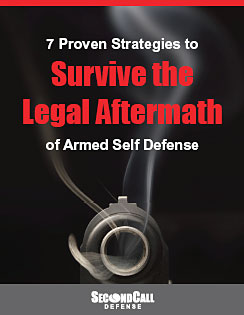Beware the Involuntary Trigger Squeeze
You’ve probably read a story or two similar to this over the years …
A police officer confronts a violent criminal. He pulls his gun and aims it at the suspect, ordering him to turn around and place his hands on his head. The suspect complies, but seconds later, the gun goes off and the suspect is shot in the back, killing him.
The officer claims it was an accident, but a prosecutor claims it was a cold-blooded execution. The officer is convicted for murder and the city is sued for millions of dollars.
So what really happened? Did the police officer intentionally shoot the suspect in the back?
During the trial, the officer’s dash cam is played showing the entire incident. Just before the suspect is shot, a car drives by and honks the horn. Immediately, the officer’s finger, which is on the trigger, squeezes hard on the trigger, causing the pistol to fire.
The officer did not “murder” the suspect. He simply fell victim to the “involuntary trigger squeeze.”
The human body is built to help you survive threatening and violent situations, something that is often referred to as the “fight or flight” response. One of the many things that happens in such situations is that your hand and finger muscles contract. So if you have your finger on the trigger of a firearm, you can have an accidental discharge. And if the muzzle is pointed at a person, the result can be lethal.
Here are three examples of how the involuntary trigger squeeze can happen:
1. You’re walking down the street with your spouse. You’ve chosen to carry a revolver in your jacket pocket and you keep your hand on it. While crossing a street, a car runs a red light and you grasp your spouse’s arm as you leap out of the way. But because your other hand is on the revolver in your pocket, and because both hands squeeze at once, you end up pulling the trigger and firing a shot into your spouses leg, causing massive blood loss and, within minutes, death.
2. You awaken in the middle of the night to investigate a noise in your home. It might be the dog, but you’re not sure. You hold your pistol at low ready, but you place your finger on the trigger. As you walk down a hallway, the family dog bursts out of a room barking. His sudden appearance and loud bark startle you, and your hands respond with a squeeze, including your trigger finger. The pistol fires, killing your pet.
3. After returning from the firing range, you decide to clean your rifle. So you grab the gun to walk down the steps to your basement workbench. When you get halfway down, you step on a toy left there by one of your children, lose your balance, and fall backward. Instantly, your arms flail and your hands tighten as your body attempts to regain balance. Because your finger was inside the trigger guard of the rifle, you squeeze the trigger of the still loaded gun, which fires a round upward through the ceiling and into the room of your son who suffers a fatal head wound.
In each of these examples, tragedy happens because of an involuntary trigger squeeze. In example one, one hand squeezing causes the other hand to squeeze – called a sympathetic response. In example two, a sudden surprise causes the hands to squeeze – called a startle response. In the example three, falling causes the hands to squeeze – called a loss of balance response.
The lesson here is to understand that your body reacts reflexively in moments of sudden stress. You can’t stop this from happening because your body is programmed to react this way as a means of self preservation. So, observing basic gun safety rules is absolutely vital.
In all of the examples above, keeping your finger off the trigger will prevent an involuntary trigger squeeze. And moreover, keeping your finger not just outside the trigger guard but FAR AWAY from the trigger, such as high up on the slide of a semi-automatic pistol, will help prevent the finger from slipping into the trigger guard when you experience a sympathetic response, startle response, or loss of balance response.
At no time should your finger be anywhere near the trigger until you are READY TO SHOOT.
You should follow every rule of gun safety, but even if you forget them all, understanding how involuntary trigger squeezes happen and keeping your finger off the trigger can help you avoid a tragic accident.

